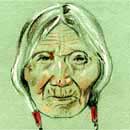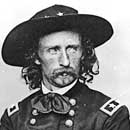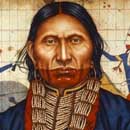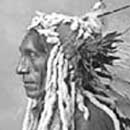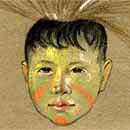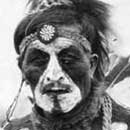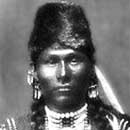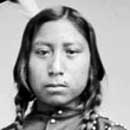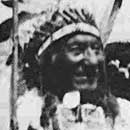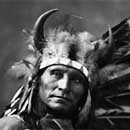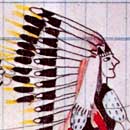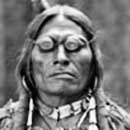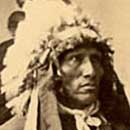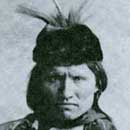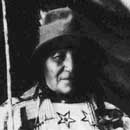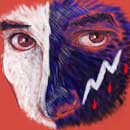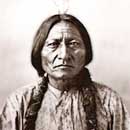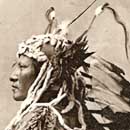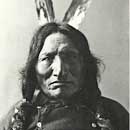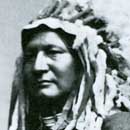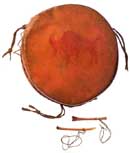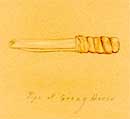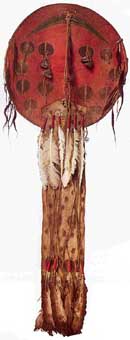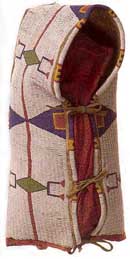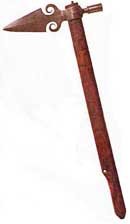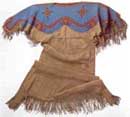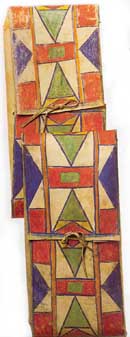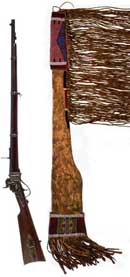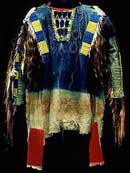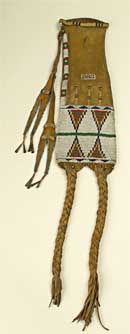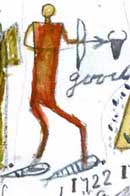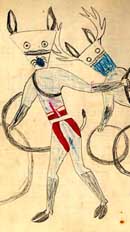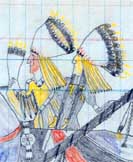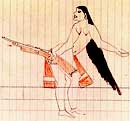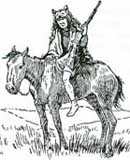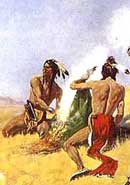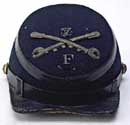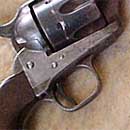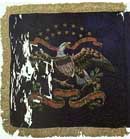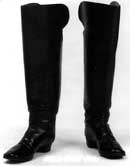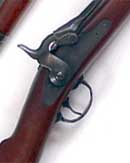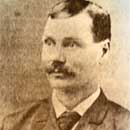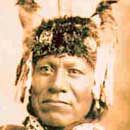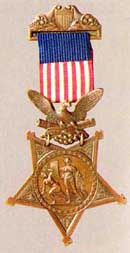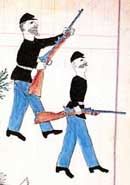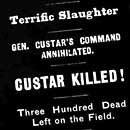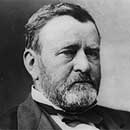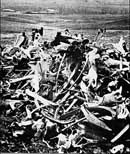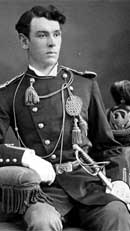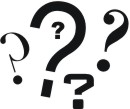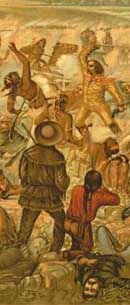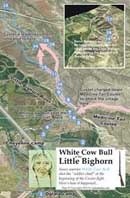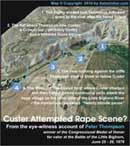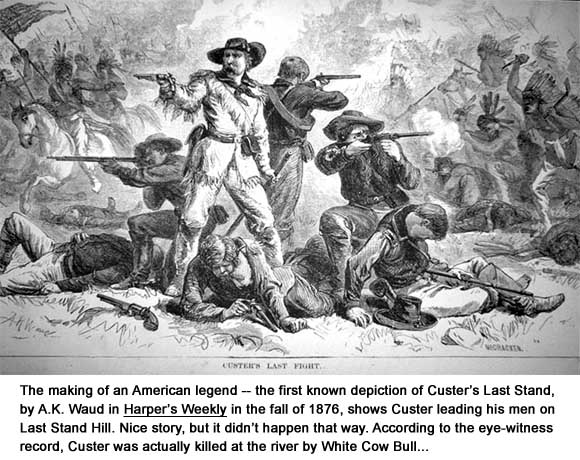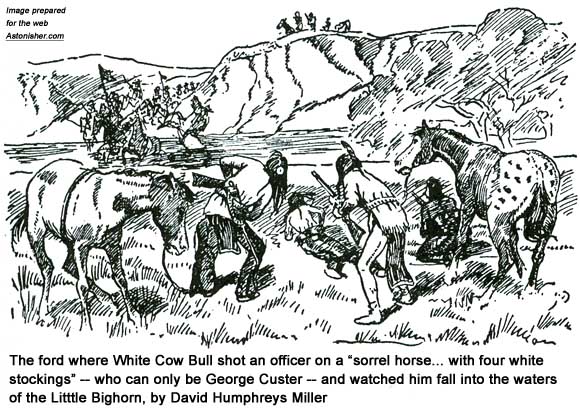 |
||
|
||
| 100 Voices: Full List * Crow/Arikara * Sioux/Cheyenne * American * Rosebud Guided Tours: Crazy Horse at the Little Bighorn * Crazy Horse at the Rosebud Features: Who Killed Custer? * Who Killed Custer? Audio Book Features: Crazy Horse Surrender Ledger * Winter Count of Crazy Horse's Life Features: Bogus Crazy Horse Photos * Unsung 7th Cavalry Scouts Saga Features: Indian Battlefield Tactics * Woman Warriors * Little Bighorn Maps Features: U.S. Medal of Honor Winners * U.S. Atrocities * Indian Atrocities Features: Little Bighorn Mysteries * Virtual Museum |
Bruce Brown's 100 Voices...
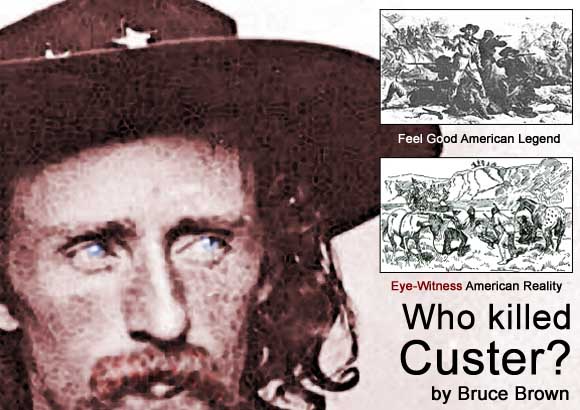 |
|||
The eye-witness answer to the eternal question...
Who Killed George A. Custer?
by Bruce Brown
|
None of these esteemed warriors actually killed Custer, though, based on the eye-witness record of the battle. To find who really killed Custer -- or at least identify the most likely suspects -- it is crucial to know the appearance of Custer and the other officers in his command on June 25, 1876. Boiled down, eye-witness Edward Godfrey's account of what Custer wore establishes that the strongest visual clue for Custer was his ironically named sorrel horse, "Victory." There were as many as seven officers on the field that day in buckskin, but only one on a sorrel horse with four white socks. Peter Thompson, the last Seventh Cavalry survivor to see Custer alive, noted Custer's "sorrel horse" and added that Custer was wearing "a broad brimmed cream colored hat on his head, the brim of which was turned up on the right side and fastened by a small hook and eye to its crown. This gave him opportunity to sight his rifle while riding. His rifle lay horizontally in front of him." Unhorsed, Custer was considerably harder to identify. Custer -- the man the Sioux called Long Hair -- had recently cut his hair short, and both Thompson and the Arikara scout, Soldier, said Custer had taken off his buckskin coat and was in his shirt sleeves. Unfortunately, any number of Seventh Cavalry officers could fit this general description: an officer in shirt sleeves with short hair. However, Custer's wounds may help identify his killer as well. Most observers agreed with Godfrey and Seventh Cavalry surgeon Dr. H.R. Porter that Custer was shot twice, once through the ribs below the heart, and once through the left temple. It is also useful to know that unlike most of the Seventh Cavalry dead, Custer was not badly mutilated. Armed with this information, we at Astonisher.com have canvassed 100 Voices -- the world's largest and most complete collection of eye-witness accounts of the battles of the Little Bighorn and Rosebud -- and assembled Astonisher.com's "Who Killed Custer -- Top Ten List." Here are the results. Stated simply, Sioux warrior White Cow Bull appears to be the man who killed George Armstrong Custer. The second most likely possibility is that Custer killed himself. Either of these top two scenarios could be true, but White Cow Bull is the prime suspect, based on the eye-witness record of the battle. The other candidates in the Astonisher.com "Who Killed Custer -- Top Ten List" include Cheyenne warriors Brave Bear, Old Bear, and Little Horse; Sioux warriors Spotted Calf, Charging Hawk and Lazy White Bull; and two Anonymous Youths (possibly members of the "Suicide Boys"). The complete "Who Killed Custer - Top Ten List" -- now grown to be the "Top 18 List" -- is displayed at right. Part 2 -- And the winner is...
White Cow Bull, a 28 year-old Oglala Sioux warrior, said he was hanging out in the Cheyenne camp that Sunday morning with a Cheyenne buddy named Roan Bear. "He [Roan Bear] was a Fox warrior, belonging to one of that tribe's soldier societies, and was on guard duty that morning," White Cow Bull recalled in a battlefield interview with David Humphreys Miller. "He was stationed by the Shahiyela [Cheyenne] medicine tepee in which the tribe kept their Sacred Buffalo Head." When word of Reno's attack on the Hunkpapa end of the village swept the Cheyenne camp, White Cow Bull watched Cheyenne war chief Two Moon lead his men out to meet the American attackers "at a gallop," but neither he nor Roan Bear joined the departing warriors because of Roan Bear's duty to guard the Sacred Buffalo Head. The two of them had just "settled down to telling each other some of our brave deeds in the past" when another alarm ran through the camp, this time announcing that the Americans were charging to attack the village at Medicine Tail Coulee across the river from the Cheyenne camp. Happily considering themselves free to join the fight against this immediate threat, White Cow Bull and Roan Bear ran to the river, where they found Bobtailed Horse, White Shield, Calf and a couple other warriors, most without guns. On the other side of the Little Bighorn were 200-plus Seventh Cavalry troopers, who charged to the river's edge in hot pursuit of a handful of Indians (alternately identified as Crazy Horse's Cheyenne decoy/scouts by Sioux warrior Foolish Elk, and as "five Sioux" by Sioux warrior White Cow Bull and George Bird Grinnell's Cheyenne informants). The Indians whipped their ponies across the ford at Medicine Tail Coulee moments ahead of the Americans. "I had never seen white soldiers before," White Cow Bull recalled, "so I remember thinking how pink and hairy they looked." White Cow Bull and the other defenders threw up a light screen of fire to cover the fleeing Indians' escape. The American soldiers halted on the opposite shore and dismounted, waiting there for a few minutes until a man in a buckskin jacket "shouted something and they all came charging at us across the ford." White Cow Bull said: "I gave the man in the buckskin jacket my attention." Cheyenne warrior Bobtailed Horse fired first and White Cow Bull saw an American soldier on a gray horse fall out of the saddle and hit the water. White Cow Bull said: "The other soldiers were shooting at us now. The man who seemed to be the soldier chief was firing his heavy rifle fast. I aimed my repeater at him and fired. I saw him fall out of his saddle and hit the water." Then an amazing thing happened. White Cow Bull said as soon as the officer on the "sorrel horse with... four white stockings" hit the water, the American charge came to an immediate and complete halt in the middle of the river. White Cow Bull said Custer's men "all reined up their horses and gathered around where he had fallen." White Cow Bull said he saw several American soldiers quickly dismount in the middle of the river and apparently pull the fallen officer's body out of the water. (The American soldiers who jumped in the river were probably one or more of the four Custer family members with Custer when he fell, including his brothers Thomas and Boston.) White Cow Bull said the officer he shot in the middle of the Little Bighorn was wearing buckskin and riding a "sorrel horse with... four white stockings." He said the officer had a mustache and a "big hat" and was "firing his heavy rifle fast" as he led the charge across the Little Bighorn. Based on the eye-witness accounts of Custer's appearance and gear on June 25, 1876 by Seventh Cavalry survivors Edward Godfrey and Peter Thompson, the man who White Cow Bull shot can only be George A. Custer. Part 3 -- Does his story check out?
In a word, yes. All the major points of White Cow Bull's story are supported by other survivors' accounts (witnesses are in parenthesis, with links to supporting portions of their eye-witness accounts of the battle)...
Taken together, there is far more eye-witness corroboration and support for White Cow Bull's story than any of the other possible Custer kill stories in the eye-witness record of the battle. So White Cow Bull's story is not only the first and best of the possible Custer kill stories, it is also the best supported. In fact, the only point of difficulty with White Cow Bull's story involves a couple small details; e.g., both Peter Thompson and Soldier said Custer had taken off his buckskin jacket and was riding in his shirt sleeves, while White Cow Bull said the officer he shot was wearing a buckskin jacket. But who knows? Thompson and Soldier's observations were made earlier, and maybe Custer put his jacket back on for the attack. Either way, Custer was the only Seventh Cavalry officer on a sorrel horse with four white socks.
Many Sioux and Cheyenne warriors spoke of the curious suicide of an American soldier on a fast, sorrel horse which was "stocking-legged" -- in other words, a sorrel horse with four white socks, which can only be Custer's famously fast sorrel horse with four white socks, Victory. As He Dog told it:
White Cow Bull added the graphic detail:
This suicide story has two important elements for identifying Custer -- the crucial sorrel horse with four white socks, and the fatal bullet wound to the head. Apart from White Cow Bull's story, the Custer suicide story is the only kill story that could actually be Custer, and apart from White Cow Bull's story, the Custer suicide story is also the best supported of the possible Custer kill stories in the eye-witness record of the battle. But there are two more Cheyenne kill stories involving an American officer on a sorrel horse at the end of the battle. Renowned Cheyenne warriors Brave Bear and White Shield also said they saw a Seventh Cavalry officer on a sorrel horse killed near the end of the battle, and White Shield identified the killer as the Northern Cheyenne warrior, Old Bear, with assistance from Kills In The Night. Both these kill stories are credible and check out as far as it's possible to check. Could one of these warriors be Custer's conqueror? Probably not. Here's why -- Old Bear shot his victim in the back between the shoulder blades, and there is no evidence Brave Bear was carrying a gun. Furthermore, neither of these accounts mentions the slain American officer's sorrel horse having four white socks, the crucial identifying mark of Custer's horse, Victory. Another problem with the American suicide and Brave Bear and Old Bear's kill(s) is that they all came at the chaotic end of the battle, after the Americans' final defensive perimeter had collapsed and anyone could have been riding a sorrel horse. Many Sioux, Cheyenne and American stories of the battle -- including the accounts of Gall, Lights, Mrs. Spotted Horn Bull, Yellow Nose, Horned Horse, John Martin and George Bird Grinnell -- described how the Indians stampeded the Seventh Cavalry's horses as the Americans retreated, producing equine mayhem on the battlefield. The same sort of problems plague all the candidates on Astonisher.com's "Who Killed Custer -- Top Ten List" -- except White Cow Bull. For instance, Rain In The Face's Anonymous Boy made his kill with a lance, not a gun; Lazy White Bull killed an officer in buckskin with short hair, but he had no mustache; Spotted Calf killed an officer with a tomahawk, not a gun, etc. But the biggest problem with the American suicide, Brave Bear and Old Bear's claims -- and all the rest on Astonisher.com's "Who Killed Custer -- Top Ten List" -- is that there is no eye-witness evidence that Custer was still alive after his initial attack at Medicine Tail Coulee. In fact, the eye-witness record indicates Custer was either killed or badly wounded before any of the other warriors on Astonisher.com's "Who Killed Custer -- Top Ten List" even got into the fight against Custer's troops. Part 5 -- Who saw Custer last?
According to the eye-witness record, the last twelve men who saw Custer alive -- and survived the battle -- all encountered him just before the beginning of the Custer fight. These were the three men who carried Custer's last orders, four Seventh Cavalry stragglers, and one Arikara and four Crow scouts for the Seventh Cavalry. Six of these men left eye-witness accounts that shed light on this question. Here are their final encounters with Custer, in chronological order, from first to last:
On the Indian side, most Sioux and Cheyenne warriors -- from Crazy Horse to He Dog to Standing Bear to Little Soldier -- admitted the Sioux and Cheyenne did not recognize Custer during the battle, or even know that Custer was the Bluecoats' commander. Several warriors like Foolish Elk, Left Hand, White Shield and Lazy White Bull saw officers in buckskin during the battle whom they later believed could have been Custer, but at the time no one knew, and those who thought they knew -- like Bad Soup -- actually had it wrong. Part 6 -- What Curley really said...
Although he was released from further service by Custer just before the attack, Curley shadowed the Americans to the river. By his own admission, Curley was there watching through binoculars when Custer tried to charge across the Little Bighorn at Medicine Tail Coulee, no more than a few minutes after Thompson saw Custer and an unnamed Crow scout (probably Curley) with a tethered Sioux squaw on the riverbank just upstream from Medicine Tail Coulee. Asked when Custer was killed, Curley stated in his first account of the battle, published in the Helena Daily Herald on July 15, 1876, "Custer remained alive through the greater part of the engagement, animating his men to determined resistance; but about an hour before the close of the fight received a mortal wound." That's it. That's the rock on which American Little Bighorn scholars have built the whole heroic Custer legend that was first depicted in the stirring etching by A.K. Waud that appeared in Harper's in the fall of 1876 and later codified in American heroic iconography by the Otto Becker lithograph, "Custer's Last Fight," that was widely distributed to American saloons and taverns a quarter century after the battle as a promotional gimmick by the Anheuser-Busch Brewing Co. Not much of a rock, especially when you consider that Curley admitted he was quite sensibly hiding in a "deep ravine" for most of the Custer fight, where he could see little of the battle, let alone whether Custer was leading his men or not at the end. Curley was frank about this. He told the Helena Daily Herald that he was "not well informed" about most of the battle. In fact, the only portion of the battle that Curley personally witnessed was at the river at the very beginning of the Custer fight, when he saw two Seventh Cavalry troopers blown out of the saddle as they tried to charge across the Little Bighorn. That's also when Curley said Custer was shot. In the same breath (the same sentence, actually) where he told the Americans what they so badly wanted to hear -- that "Custer remained alive through the greater part of the engagement" -- Curley also slipped the Americans the cold, hard truth -- that Custer was mortally wounded "an hour before the end of the fight." Curley didn't estimate the total length of the Custer fight -- and there is disagreement in the eye-witness record on this point -- but witnesses on both sides (such as Sioux warriors He Dog, Lazy White Bull, Flying Hawk and American scout George Herendeen) agreed that the second portion of the battle -- the Custer fight -- lasted about "an hour." If that's true, Curley wasn't saying Custer was killed at the end on Last Stand Hill at all, but rather the opposite! What Curley was actually saying was that Custer died at the outset of the Custer fight, about the time Curley saw a couple of Custer's men get shot out of the saddle charging across the Little Bighorn, and White Cow Bull shot an officer on a "sorrel horse with... four white stockings" in the middle of the river. This is also when Pretty Shield said Custer "died in the water of the Little Bighorn." And Gall and Crazy Horse agreed. Although they didn't know the specifics of Custer's death, both Crazy Horse and Gall -- the powerful Oglala and Hunkpapa Sioux war chiefs who were hammer and anvil for the Seventh Cavalry that day in June 1876 -- judged from the way the battle unfolded that Custer was killed early in the Custer fight. Gall said, "Custer personally and those with him were probably the very first ones to fall in the day," and Crazy Horse said, "we disposed of the leaders in a very short time and if he [Custer] was unfortunate enough to be one of the groups in the lead he was one of the first to fall." Minneconjou Sioux warrior Hump struck a similar note in 1881 when he recalled that Custer's men seemed "confused" -- i.e., leaderless -- from the time the Indians counter-attacked at Medicine Tail Coulee -- i.e., from near the beginning of the Custer fight -- and Sioux warriors Lights and Hollow Horn Bear described the retreating Americans as "demoralized." Horned Horse and Curley and Jacob Adams agreed. Horned Horse described how Custer's men "reeled back toward the bluffs after losing several men who tumbled into the water," and Seventh Cavalry survivor Jacob Adams, who went over the battlefield on June 27, said the physical evidence of the American dead indicated little corps cohesion or discipline during the retreat from Medicine Tail Coulee. "It seems to me evident that all organization was gone after the first demoralization, for the slain of all companies were scattered promiscuously, without regard to company formations," said Adams. "These soldiers were simply overwhelmed and overpowered." Curley, who watched the start of the Custer fight from a safe distance, said that Custer's men fought poorly from the beginning. Curley said it looked like Custer's men "did not know much about fighting," something that could NOT be said of troops actively commanded by George A. Custer!
Consider what happened next -- right after White Cow Bull said he shot an officer on a "sorrel horse with... four white stockings" and Pretty Shield said Custer "fell in the water." As quickly and completely as if you'd thrown a switch, Custer disappeared from all further eye-witness accounts of the battle and his men simultaneously lost all strategic direction. Custer's men continued to show some tactical capacity for a while longer -- e.g., their charge to drive back the Indians gathering lower down on Calhoun Ridge, as Wooden Leg and Foolish Elk described -- but there is no further evidence of any strategy on their part, or any will to press the offensive Custer had thrown his men into so enthusiastically mere minutes before. Nor did Custer's men do what the circumstances desperately demanded, which was to reunite with the troops under Marcus Reno and/or Frederick Benteen. History demonstrates this was their only chance for survival, but after the charge at Medicine Tail Coulee was thrown back, Custer's men didn't continue the attack, and they didn't maneuver for reinforcement either. Custer's men simply presented themselves on the doorstep of the largest Plains Indian village in recorded history, fired two signal volleys so everyone within 10 miles knew exactly where they were, and then obligingly waited -- as Cheyenne warriors Soldier Wolf, Brave Wolf and Tall Bull recounted -- for the Indians to gather enough force to drive them like a nail, strong circumstantial evidence that Custer was still alive at this point, but so badly wounded that his men feared that he would die if they moved him. The accounts of Seventh Cavalry survivors with Reno and Benteen clearly indicate that they expected support from Custer, support which never came. Medal of Honor winner Charles Windolf expressed it bluntly when he asked, "Where was Custer?" Windolf concluded, "All we knew was that he had disappeared with half the regiment." William Slaper added, "I was, however, considerably worried about ... where Custer was and why he had failed to support us as he had promised to do." In fact, Custer's men continued to believe that Custer was going to ride to their rescue through the night of June 25 - 26. When Reno ordered his men to entrench that night, the response was lackluster because "they doubtless expected that General Custer would make his appearance during the night and that our labor would be wasted," recalled William O. Taylor. And John Ryan remembered, "About the middle of the night we heard a trumpet call, and the men commenced to cheer, thinking it was Custer's men who were coming to our assistance. Major Reno ordered one of our trumpeters to sound a call, but it was not repeated, so we made up our minds that it was a decoy on the part of the Indians..." William O. Taylor and Peter Thompson also described the same scene with the Indian trumpeter. Custer loyalist John Burkman overheard Reno's bitter comments about Custer that same night, and Seventh Cavalry Surgeon Dr. Henry Porter recalled how "during the two days we were surrounded by the Indians the inquiry among our men for Custer was loud, and that General's court-martial was freely speculated upon." Custer's surviving men couldn't understand why their commander hadn't supported them and the attack he ordered. Although they had no idea what had befallen Custer, his men knew there was something deeply wrong in Custer's behavior, and they were right. If Custer was still compos mentis and commanding his men, it is impossible to imagine him meekly allowing a handful of defenders to both thwart his attack on the village AND prevent any him from taking any further action to support or reinforce Reno and his men. This is especially true since Custer already knew from FOUR of his scouts -- Hairy Moccasin, Goes Ahead, White Man Runs Him and Fred Gerard -- that the 112 Seventh Cavalry troopers he sent with Reno badly needed his support.
From the intelligence he had received before the battle, Custer knew that Reno and his men were out-numbered by at least 10-to-1, and possibly by as much as 15-to-1. Without the support he had promised them, Custer knew these men were on a suicide mission. White Man Runs Him, Standing Bear, Horned Horse and Mrs. Spotted Horn Bull all agreed that Custer allowed "what seemed quite a long interval" of time to pass between Reno's charge and his own attack on the village (possible evidence of Custer's ruthless glory seeking, or perhaps simply his inability to find a suitable place to cross the river). By the time Custer led the charge down Medicine Tail Coulee, the time for waiting was over. The battle was raging and Custer knew from his scouts that Reno's men were literally getting annihilated. He had asked these 112 men to bleed for him; now they were bleeding and they badly needed the support he promised them. At this point, it was imperative for Custer to immediately support his men -- either by diversionary attack or direct reinforcement -- as every observer (Frederick Benteen, Marcus Reno, William Edgerly, William Slaper, the Findings of the Marcus Reno Court of Inquiry, etc.) agreed Custer said he would. Custer's number two in command, Marcus Reno, recalled how he received his orders from Custer just before the beginning of the battle. "I was given the command of Companies M, A and G," Reno said, "and was ordered [by Gen. Custer] to proceed at as rapid a gait as I thought prudent and afterward to charge, and that I would be supported by the whole outfit. This order was brought to me by Colonel Cooke, adjutant of the regiment... "After Colonel Cooke gave me these instructions he rode with me for some time, as also Captain Keogh, and said, in his laughing, smiling, way, 'We are all going with the advance and Miles Keogh is coming too.'" Instead, Keogh's body was found where he fell during the retreat from Medicine Tail Coulee, in a heap with the corpses of nearly 40 of his men, while Cooke fell farther up the hill, where Cheyenne warrior Wooden Leg scalped one of his long muttonchop whiskers. So what happened? Custer's attack at Medicine Tail Coulee was the sort of battlefield moment that Custer lived for, when everything was on the line and great glory was there to be won. Why didn't Custer continue his attack at Medicine Tail Coulee when he had the element of surprise and a virtually undefended ford in front of him? Or alternately, why didn't Custer maneuver to join forces with Reno and directly reinforce his beleaguered command when Custer knew from FOUR of his scouts that Reno's men were in big trouble? This is the central enigma of the Battle of the Little Bighorn -- why did Custer apparently freeze at the crucial moment in the battle? Did Custer lose his nerve? Or perhaps his mind? The eye-witness account of Billy Jackson (as told by James Watson to Peter Thompson) suggests that Custer may have possibly "lost it" at the end, but there is no hint of cowardice in the eye-witness record of Custer at all. Part 9 -- Custer did NOT freeze...
John Martin, who carried Custer's last order to Benteen, recalled that just before the charge at Medicine Tail Coulee, Custer told his men what he planned to do, stating confidently: "We will go down and make a crossing and capture the village." Three of Custer's Crow scouts -- White Man Runs Him, Goes Ahead and Curley -- testified that Custer did what he said, leading his men down Medicine Tail Coulee to attack the Indian village on the other side of the Little Bighorn River. Curley said that when the Indian village came in sight, "Custer appeared very much elated, and ordered the bugles to sound a charge." Seventh Cavalry trooper Peter Thompson also described how he and the rest of Custer's command began to charge on sight of the village. Daniel Kanipe recalled, "the men were on the hill, we all gave them three cheers riding at a full gallop, some of them couldn't hold their horses, galloping past General Custer. He shouted at them, "Boys, hold your horses, there are plenty of them down there for us all." Brule Sioux warrior Foolish Elk, who was sitting in front of his lodge across the river in the Indian village, caught sight of the American soldiers at the same moment. He remembered, "a trumpet blared and they began to gallop," while Hunkpapa Sioux observer Mrs. Spotted Horn Bull (also called Pretty White Buffalo Woman) remembered "the music of the bugle" as Custer's men rode "down to the river to where the attack was to be made." Excused from further service by Custer, the Crow scouts parted company with the American soldiers just after Martin departed with Custer's last order for Benteen, but all four continued down to the river independently, bent on their own dark business. From the banks of the Little Bighorn, and subsequently from the bluffs above while they were fleeing for their lives, the four Crow scouts caught some of the last living glimpses of Custer's doomed command. Here are their primary memories. White Man Runs Him said Custer "tried to cross the river... but was unable to do so. This was the last time we saw Custer." Curley, who was not with the other three, said much the same thing. "They (the Sioux) would not let the soldiers cross the river," Curley recalled in 1916. When Custer tried to charge aross the Little Bighorn, Curley saw "two of Custer's men killed who fell into the stream." A short time later -- before the Indians had marshalled enough strength to cross the river and drive the Americans back -- Goes Ahead heard Custer's men fire "two volleys." Part 10 -- At Medicine Tail Coulee...
For instance, on the tenth anniversary of the Battle of the Little Bighorn, Hunkpapa war chief Gall essentially said that the second, "Custer fight" portion of the battle didn't begin until he got there, and flatly denied that Custer ever charged to the river at Medicine Tail Coulee. As important as Gall was to the Indian cause that day, he was wrong on this point, as the overwhelming eye-witness evidence demonstrates. In fact, Gall didn't know what happened at Medicine Tail Coulee because he wasn't there at the crucial moment when Custer led the Seventh Cavalry's charge across the Little Bighorn. Almost no one was there -- except some fleeing women and a handful of warriors, mostly Cheyennes: Bobtailed Horse, White Shield, Roan Bear, Mad Wolf and Calf. Oglala Sioux marksman White Cow Bull was the lone Sioux present at the beginning. The only Hunkpapa observer was Mrs. Spotted Horn Bull, who described Custer's charge down Medicine Tail Coulee but did not see what happened at the river. None of the Hunkpapas saw what happened at Medicine Tail Coulee. Why? Because Reno's surprise attack hit the Hunkpapa portion of the village first, murdering women and children, the Hunkpapas were fiercely focused on the Reno fight. Crow King, Gall, Rain In The Face and Hawk Man were among the Hunkpapa war chiefs who figured prominently in the early fighting, which halted Reno's advance and forced the first American retreat. When Custer led the charge at Medicine Tail Coulee, Gall was still miles away fighting the troops under Reno who had murdered his family. According to an 1883 account by Mrs. Spotted Horn Bull, Gall didn't get into the Custer fight until after Custer's men had been driven back from the river. However, the Seventh Cavalry's four Crow scouts were there at Medicine Tail Coulee at that crucial moment, and in a 1919 battlefield interview with Gen. H.L. Scott, White Man Runs Him declared emphatically, "I know for sure that Custer went right to the river bank. I saw him go that far. The Sioux were right across the river." White Cow Bull was one of the Sioux who were "right across the river" at that moment, and he said the same thing. White Cow Bull also said the American soldiers paused briefly at the river -- just as Marcus Reno had done with his men before attacking the other end of the village -- and White Shield and Peter Thompson agreed. White Shield described how, when Custer's men "got pretty close to the river, they dismounted, and all the soldiers back as far as I could see stopped and dismounted also." Then, moments before the attack, Thompson saw Custer riding along the banks of the Little Bighorn, personally scouting for a better place to cross the river, a peculiar but well-documented habit of Custer's. Crow scout Curley said the problem with crossing at the ford at Medicine Tail Coulee was "it only could be done in column of fours," meaning the American soldiers had to ride in relatively tight formation which made them more vulnerable to enemy fire, a dead-on observation, as it turned out. Sioux warrior Horned Horse also said there was a problem with "quicksand" at the Medicine Tail Coulee ford.
Because the Little Bighorn was bounded on one side by steep bluffs, and on the other by ticket and the huge free Sioux and Cheyenne village (Note: see Peter Thompson Detail Map and Custer Attempted Rape Scene Map for more info), Custer actually rode in the riverbed much of the way, meaning he left no trail until he clambered out of the water on the first flat. And it was there, on the first flat along the Little Bighorn above the ford at Medicine Tail Coulee, that Custer was last seen alive. Two Seventh Cavalry stragglers, Peter Thompson and James Watson, encountered Custer there moments before the Seventh Cavalry's attack at Medicine Tail Coulee. Thompson said almost as soon as he and Watson followed the highly eroded trail to the river, they more-or-less simultaneously stumbled on Custer and one of Custer's Crow scouts in the midst of an apparent war crime with a tethered Sioux squaw. Custer's troops had begun the Battle of the Little Bighorn much as Custer had begun the Washita Massacre eight years before -- with an unprovoked, sucker-punch attack, murdering women and children (starting with the Sioux boy Deeds), shooting at One Bull (the man Sitting Bull deputized to ask for parley with the American attackers) and setting fire to the village. But here, on the banks of the Little Bighorn in the last few minutes of his life, Custer apparently acquitted himself with honor. According to Thompson, Custer rode straight to the Crow scout -- probably Curley (who was alone at the river at that exact moment) -- and "commence[d] to talk to him" by sign language, whereupon the scout released the Sioux woman he had roped. I say, "Custer apparently acquitted himself with honor," because you can explain Custer's actions this way -- as the necessary and direct actions of an honorable man -- but there is also another plausible explanation for the scene that Thompson and Watson stumpled upon. This is that Curley was actually Custer's procurer. In other words, it's possible that Custer wasn't there on a quick scout at all. And when you think about it, the scouting alibi really doesn't make much sense. Why would Custer scout a route that required his men to ride in the river for almost 1,000 feet and took them into an area where the thicket along the river was particularly dense? The area that Custer rode into alone that afternoon was secluded, with limited access on the cliff side -- except the highly eroded trail that Thompson and Watson came down (Note: See Peter Thompson Detail Map and Custer Attempted Rape Scene Map for more info). Why would Custer scout a route that seems to lack the qualities you'd look for in a good attack route? Well, perhaps Custer was there because he knew ahead of time that there would be a roped Sioux woman waiting for him on the first flat along the Little Bighorn upriver from the ford at Medicine Tail Coulee. Perhaps that had the been the true mission of Curley -- at age 19 the youngest, most impressionable and most easily swayed of Custer's scouts -- when Custer had Mitch Bouyer release him part way down Medicine Tail Coulee. In fact, Custer had previously enjoyed the forced embrace of his Southern Cheyenne prisoner of war translator and concubine, Monaseetah, and he had spoken openly of his desire for a Sioux woman. "The Indians have a joke about it," recalled Cheyenne chronicler John Stands In Timber. "Beaver Heart said that when the scouts warned Custer about the village he laughed and said, 'When we get to that village I'm going to find the Sioux girl with the most elk teeth on her dress and take her along with me.' So that was what he was doing those twenty minutes, looking [for a 'Sioux girl']." Going in, this sort of "little skirmish" (as Strikes Two described the Arikara scouts' murder of a dozen Sioux women at the outset of Reno's attack on the other end of the village 20 minutes or so before) might have looked like the perfect crime. First Custer and then Curley would get to rape the woman, and then they'd kill her, and no one would be the wiser. The woman would just be another tragic victim of the battle -- sad surely, but what was one to do? Custer was particularly protected in this scenario, it would seem: he left no trail when he rode in, and the only other witness to the alleged murder/rape would be a mere child, whose word would carry no weight at all compared to Custer's, if it ever came to one person's word against another's. Meanwhile, Custer would enjoy "the pause that refreshes" and Curley would get a little ghonoreaic "hot buttered bun," and a chance to hobnob with a popular celebrity and see how great American heroes behave when they're relaxing in private. If this was the case, Thompson and Watson showing up unexpectedly would have completely spoiled Custer and Curley's little party. No matter how much Custer might want a "Sioux girl" or desire to teach the Sioux "a lesson," Custer wasn't going to rape the squaw in front a white audience. (On the other hand, having a "savage" attend his savagery would be useful in order to literally "cover his ass," as the expression goes.) So Custer ordered the woman released, as Thompson witnessed. At this point, it's imposible to know which of these two scenarios is true -- Custer as rapist or Custer as rescuer -- but whatever the actual back story here, Thompson recalled that "she [the tethered squaw] seemed glad to be free [and] came running towards us in a half stooping posture and in her hand was a long bladed knife of ugly dimensions. So fierce did she look that my hand involuntarily sought the handle of my revolver." Then Custer motioned to Thompson and his companion, Pvt. James Watson, to follow him, and rode quickly back along the river bank the way he came. Thompson and Watson were on foot, though, so fortunately (as it turned out for them) they couldn't keep up with Custer, who spurred Victory back to his 200-plus men waiting at the ford downriver, and defeat. White Cow Bull saw Custer across the river when he returned from this quick "scout," although he didn't know who the American "soldier chief" was. White Cow Bull said: "The man in the buckskin jacket seemed to be the leader of these soldiers, for he shouted something and they all came charging at us across the ford." From the eye-witness accounts of Cheyenne warriors White Shield and Bobtailed Horse, as well as Sioux warriors White Cow Bull and He Dog, and Cheyenne chronicler George Bird Grinnell, we know that the ford where Custer tried to cross the Little Bighorn was very thinly defended, as Custer likely hoped and anticipated. So how could less than a dozen warriors (many like White Shield without a gun) turn back the charge of more than two hundred Seventh Cavalry troopers with Custer in the lead? Part 12 -- Custer 'died in the water'
Before the vanguard of the charge got across the river, Custer took a slug in the ribs below the heart from the repeating rifle of the Oglala Sioux marksman, White Cow Bull, and toppled from his saddle into the river, either dead or so badly wounded that he was not a factor for the remainder of the battle. This is not the heroic Custer story that the Americans like to tell themselves (the one full of buckskin bravado to the bitter end), but a few of the Indians -- supported by a few Seventh Cavalry survivors -- have been trying to tell a different story from the beginning. In his first eye-witness account of the battle, Curley said he saw "two of Custer's men killed who fell into the stream." Describing the same moment in the battle, White Cow Bull (who was much closer to the action than the furtive Curley) said the second trooper shot mid-river was an officer on "a sorrel with... four white stockings" -- in other words, Custer himself, although White Cow Bull didn't know it at the time! Crow chronicler Pretty Shield, who gave the Crow scouts' candid, for-family version of what happened that day, told the same story from the Seventh Cavalry side. She said both Goes Ahead (her husband) and Half Yellow Face (her uncle, the leader of the Seventh Cavalry's Crow scouts) told her that Custer was shot at the outset of the battle -- not the end -- and "died in the water of the Little Bighorn." White Cow Bull said the Seventh Cavalry's charge stopped the moment the officer on the sorrel horse was blown "out of his saddle and hit the water," whereupon the American troopers "all reined up their horses and gathered around where he had fallen," exactly the sort of rudderless behavior that characterized Custer's men for the last hour of their lives. According to Seventh Cavalry survivor George Glenn, the physical evidence the day after the battle supported what White Cow Bull said. Glenn, who went over the battlefield on burial detail, said: "We found [the] trail [of Custer's charge] going down in the river, but it seems that Custer got repulsed before he got across the river ... [because] we never found any trail of him on the other side of the river." Jacob Adams, another Seventh Cavalry survivor who went over the battlefield on June 27th, said the same thing -- that the physical evidence the day after the battle indicated that charge by Custer and his 200-plus troopers at Medicine Tail Coulee was suddenly halted mid-river. "My own impression is that the general was attacked about the middle of the ford, as many of the troopers' horses lay dead in the river and there was no evidence that any of them had ever reached the village across the stream." White Cow Bull said two American soldiers besides Custer were shot out of the saddle and fell into the waters of the Little Bighorn, while Curley said he saw "two of Custer's men killed who fell in the stream." Cheyenne warrior Soldier Wolf said "two soldiers were killed and left there," and Sioux war chief Horned Horse spoke of Custer "losing several men who tumbled into the water." Pretty Shield agreed, naming one of the dead as Mitch Bouyer, Custer's half Sioux interpreter for the Crow scouts. White Cow Bull said he saw a "small man on a dark horse," who was probably Bouyer, riding beside the officer on a "sorrel horse with... four white stockings," but White Cow Bull did not see him shot. Both Seventh Infantry scout Thomas LaForge and Arapaho warrior Sage, or Well Knowing One, told a story that seems to fit like a piece in a jigsaw puzzle with the story told by White Cow Bull and Pretty Shield. Essentially, Sage and LaForge said Bouyer was badly wounded at the river, but did not die, and LaForge added that Bouyer was shot in the back, which could explain why White Cow Bull didn't see it -- it happened after gunsmoke had obscured the river and Custer's men were pulling back to the far shore. LaForge and Sage said Bouyer subsequently struggled to the edge of the river at Medicine Tail Coulee, where he was discovered by the Sioux after the battle. Bouyer begged to be killed and was accommodated, after which the Sioux threw his body into the river. Sage spoke of two wounded Americans found at the edge of the river who were killed by the Indians -- Bouyer and "a soldier with a bugle and a carbine." Curley also identified one of the Americans killed at the river as "the bugler," adding that the bugler was the only American who actually got across the river into the Cheyenne camp. Brule Sioux warriors Hollow Horn Eagle and Brave Bird told a story about the bugler which seems to provide another piece of the puzzle. As with Bouyer, they said the bugler was badly wounded but not dead when he was found after the battle by Woman Who Walks With The Stars, wife of Brule chief Crow Dog. It was Woman Who Walks With The Stars who finally killed the bugler, probably Henry Voss. According to Reno's official report on the burial of the dead, dated July 5, 1876, the Americans never found Bouyer's body, but LaForge, who was an eye-witness to the condition of the battlefield immediately afterwards, noted that "Boyer's vest, made of the skin of a spotted calf, was found near the river after the battle." And according to George Glenn, the Seventh Cavalry burial detail found "the body nearest the river was that of the chief trumpeter [Henry] Voss." August DeVoto, another Seventh Cavalry survivor who was also on burial detail, recalled they found Voss "all alone and stark naked. His body was in a kneeling position and his back was stuck full of arrows." Part 13 -- After Custer fell...
The Crow scouts were whipping their horses for the horizon, and Custer's Arikara scout, Black Fox, was already long gone. It was at this point -- after Custer's men had retreated back to the far side of the Little Bighorn River, but before the Indians were able to cross the river and drive them back up the hill -- that Crow scout Goes Ahead saw and heard Custer's troops fire two controlled volleys. Two volleys were also heard by some of the troopers fighting for their lives with Reno a couple miles away, including John Burkman and Edward Godfrey, both of whom later believed the double volley was intended as a distress signal or a location indicator. Peter Thompson, who was hiding in an oxbow just upriver from the mouth of Medicine Tail Coulee, also apparently caught a glimpse of Custer's men shortly after Custer fell. He saw Custer's troops on the banks of the Little Bighorn across from the village, "drawn up in battle line, two men deep." After some light skirmishing at the ford where Custer fell, a rapidly growing Indian force commanded by Cheyenne war chiefs Contrary Big Belly, Yellow Nose, Lame White Man and Comes In Sight (the latter the brother of the renowned Cheyenne woman warrior, Buffalo Calf Road Woman) crossed the river and drove Custer's decapitated command back in disarray. Minneconjou Sioux warrior Hump recalled in 1881 that Custer's men seemed "confused," and Oglala Sioux war chief Horned Horse painted a similar picture. Horned Horse, who was a lieutenant and spokesman for Crazy Horse, said, "He [Custer] made a dash to get across [the Little Bighorn], but... the head of his command reeled back toward the bluffs after losing several men who tumbled into the water..." You can get an idea how rattled the Americans were from the fact that they abandoned the body of New York Herald correspondent Mark Kellogg a "stone's throw" from the Little Bighorn, but Cheyenne warrior Hanging Wolf also saw them rescue a trooper whose horse had been shot and carry him with them as they retreated. When John Martin, who was carrying Custer's last order (the famous "Big village. Be quick. Bring packs." message) looked back at his comrades for the last time from "high ground," he "saw Custer's command over on the flat and Indians over in the village riding toward the river and waving buffalo hides [to stampede the Americans' horses]. The battalion appeared to be falling back from the river." Peter Thompson also got a look at Custer's men for the last time when they were retreating up Calhoun Ridge under heavy attack from the Indians, who by then deployed a sort of living Gattling gun against the Americans, one of several clever Indian battlefield tactics at the Battle of the Little Bighorn. It was at this point that Rain In The Face's Anonymous Youth and Spotted Calf made their kills, which are Number 5 and Number 6 respectively on Astonisher.com's "Who Killed Custer -- Top 10 List." Apart from timing, the problem with the stories of the Anonymous Youth and Spotted Calf is that neither of them was carrying a gun, and Custer died of gunshot wounds. All the other possible Custer kills on Astonisher.com's "Who Killed Custer - Top 10 List" -- actually numbers seven through 18 -- occurred after this, in the mayhem at the end.
Large numbers of them -- including warriors commanded by Sioux war chiefs Sitting Bull, Crow King, Gall and Runs The Enemy -- hastily turned to confront Custer's men, who were by then retreating from the Cheyenne along the ridge above the river, while Sioux war chief Crazy Horse rode with a joint Sioux and Cheyenne force to flank the Americans, repeating his devastating flanking move against Reno, which broke the Americans' line in the timber and began the killing rout in the Reno fight only a few minutes before. A vengeful Gall, who led a strong contingent of Hunkpapa Sioux, recalled in 1886, "The Indians were in coulees behind and in front of Custer as he moved up the ridge to take position, and were just As Many As the Grass..." Reporting of the quick afternoon sortie led by Captain Thomas Weir of Reno's Company M to try to discover what happened to Custer, Seventh Cavalry survivor Edward Pigford said that "the appearance of Indians coming from Custer Ridge toward Weir hills looked as thick as grasshoppers in a harvest field." The Helena Daily Herald wrote, "Curley says the firing was more rapid than anything he had ever conceived of, being a continuous roll, like (as he expressed it), "The Snapping of the Threads in the Tearing of a Blanket." Peter Thompson also described the incredible din as the battle ignited to full fury and the Sioux and Cheyenne squaws began wailing for loved ones lost. "The noise gradually became louder and louder until it became indescribable and almost unbearable to the ears of civilized persons," recalled Thompson. Among the free Sioux, many spoke of the battle clamour too. Blackfoot Sioux war chief Kill Eagle said the noise of the battle was "simply terrific" and at its height, Minneconjou Sioux warrior Standing Bear said the sounds of the gunshots -- Curley's "Snapping of the Threads in the Tearing of a Blanket" -- all merged into one unified, all-consuming roar. "There were so many guns going off that I couldn't hear them," remembered Standing Bear. In the early going, many of Custer's men fought coolly and courageously until they were overwhelmed and killed. Gall, who was an eye-witness to the action on Calhoun Ridge, said Lieutenant James "Calhoun's men died fighting as skirmishers, while Keogh rallied his company, which was all killed in a bunch." The corpses of Captain Myles Keogh and nearly 40 of his men were found in a heap after the battle. White Cow Bull remembered "it was a day of bravery -- even for our soldier enemies" who "fought well and died in courage," while Cheyenne warrior Soldier Wolf recalled, "Custer's men fought well and bravely," and even Sioux war chief Sitting Bull said of the hated American invaders, "They were brave men." However, many Sioux and Cheyenne warriors also described the Seventh Cavalry troopers they faced as "cowardly," "drunk" and "confused," or what Sioux warriors Lights and Hollow Horn Bear termed "demoralized." And Sitting Bull, when he was done making statesman-like pronouncements, compared Custer's soldiers to "Quaking Aspen," saying with typically deadpan Indian wit, "these were the Long Hair's [Custer's] soldiers." The eye-witness record also clearly demonstrates another aspect of the battle that Americans have preferred to ignore for a century and a half -- the fact that many of the American soldiers at the Little Bighorn committed suicide. In addition to the curious suicide of the lone American -- who could be Custer -- on the fast horse at the end described by He Dog, White Cow Bull, Wooden Leg, Foolish Elk, "group suicides" by American soldiers were described by the Sioux and Cheyenne, including Wooden Leg, Turning Hawk, Turtle Rib, Kate Bighead, Black Wolf, Pine, Limpy, Bobtail Horse, Rising Sun, Red Fox, and Dives Backward. Rain In The Face said other American soldiers "got on their knees and begged" in vain for their lives, recalling eye-witness Henry Lemly's tale of how an American soldier handed his gun to "the nearest Sioux" warrior at the Battle of the Rosebud, and was promptly killed with it. This breakdown of command and tactical cohesion among the Americans further demonstrates that Custer was no longer "animating his men to determined resistance," as Curley put it. The desperate men in Custer's rudderless command may have spent that last hour of their lives waiting for steely Frederick Benteen, whom Custer had summoned in his last order, or they may have simply had no idea what to do with the mortal mess Custer had gotten them into. Either way, Benteen was never coming. While responding to Custer's last order, Benteen had run into Reno's badly mauled troops and stopped to provide them the support Custer had promised, but never delivered to the point men on the American attack. Describing how he found Reno, Benteen wrote to his wife ten days after the battle:
White Man Runs Him believed that Benteen saved the lives of Reno and his men. "If those soldiers [Reno's men] hadn't turned back and been reinforced by the pack train they would all have been killed. The Sioux were coming up fast." However, by the time Benteen and Reno secured their defense and sent out a sortie to look for Custer, it was too late for the 212 men in Custer's command. So instead of Benteen, Custer's men got Lame White Man and Brave Bear and Yellow Nose and Two Moon and Wooden Leg and Gall and Crow King and Rain In The Face and Red Horse and American Horse and Moving Robe and Low Dog and He Dog and Hump and Charging Hawk and Little Hawk and Flying Hawk and Waterman and Short Bull and Lazy White Bull and One Bull, White Cow Bull and the greatest of the 19th century Native American mujahidin, Sitting Bull and Crazy Horse -- all with "splendid" Indian command -- and no help at all from the prostrate form of George A. Custer, which his men carried with them like a proverbial dead weight until nearly the end. Part 15 -- Custer's men, all alone at the end...
One of them -- the Accepted Consensus View taught to virtually every American child for over a century -- has Custer dying at the end on Last Stand Hill. Unfortunately, as discussed above, there is no eye-witness support for this theory at all. It therefore rests entirely on the circumstantial evidence of where Custer's corpse was found, which is meaningless under the circumstances. As the eye-witness accounts of Seventh Cavalry surgeon Dr. H.R. Porter, Peter Thompson, Edward Pigford and William O. Taylor vividly indicate, the Americans were terrified of falling into the hands of the "savages," realistically fearing they would be tortured in life and mutilated in death. Seventh Cavalry troopers were willing to risk their lives to prevent dead and dying comrades from falling into Indian hands, as the case of Pvt. James J. Tanner on the night of June 25 illustrates. There is no doubt that Custer's retreating men would have carried their fallen leader with them, dead or alive, especially since four of Custer's family were with him when he fell -- his brothers Thomas Custer and Boston Custer, his nephew Henry Armstrong Reed and his brother-in-law James Calhoun. And the eye-witness record indicates that Custer was badly wounded by White Cow Bull at Medicine Tail Coulee, but NOT killed. Jacob Adams, who went over the battlefield the day after the battle and was the American who actually found Custer's corpse, provided the most detailed description of Custer in death. Adams said, "General Custer had two wounds, one in the right side of the breast, the other in the left temple above the eye. The blood was still oozing from the wound and running down over his face and his mustache being turned into his mouth, the blood had coursed through the mouth and out at the lower side." There was no way Custer's head wound would still be oozing blood if he was dead when he was shot in the head. Either way, though, the Americans would have certainly carried Custer's body with them. You can gauge the strength of the American impulse to carry Custer's body from the fact that William O. Taylor thought they should have continued to carry it back to Fort Lincoln. "There was plenty of salt," he said. Fact is, the Accepted Consensus View of the Battle of the Little Bighorn is simply unable to explain many important aspects of the battle, such as why Custer abandoned his attack at Medicine Tail Coulee in the middle of the river, why Custer didn't directly reinforce Reno, how and when Custer was killed, what happened to Curley, etc. In short, the Accepted Consensus View of the Battle of the Little Bighorn is riddled with Ptolmeic problems, and simply doesn't square with the facts of the battle from the eye-witness record. The eye-witness record says Custer was shot at the beginning of the Custer fight when Custer did what he told his men he intended to do -- which is to say, charge across the ford at Medicine Tail Coulee and attack the huge Indian village on the other side of the Little Bighorn. Nor are the problems with the Accepted Consensus View of the Battle of the Little Bighorn restricted to Custer. The story the Americans teach their children also makes a shameful hash of the Seventh Cavalry's Indian scouts' story -- see The Twisted Saga of the Seventh Cavalry's Unsung Scouts for more info. Then there's the other explanation for the Battle of the Little Bighorn: the eye-witness explanation. White Cow Bull's account of shooting an officer on a "sorrel horse with... four white stockings" -- who can only be Custer -- at the beginning of the battle is supported in its various parts by nearly two dozen other eye-witness accounts from Sioux, Cheyenne, Arapaho, Crow and American survivors of the battle. It also makes sense and simultaneously resolves most of the persistent problems with the Accepted Consensus View cited above. So it turns out the eye-witness record of the Battle of the Little Bighorn reveals that the cherished American picture of Custer standing heroically erect in buckskin at the end is "a lie," as Pretty Shield put it, the sort of big, heroic, self-serving lie that Americans love to tell themselves, then (during America's illegal, immoral, atrocity-laced invasion of the Great Sioux Nation) and now (during America's illegal, immoral, atrocity-laced invasions of Afghanistan and Iraq). Check it out. Each "Top Ten" (actually "Top 18") thumbnail at the top right is linked to the related portion of the supporting eye-witness account... -- Bruce Brown |
|
According to the eye-witness record, this is the way it really happened...
 |
 |
 |
 |
© Copyright 1973 - 2020 by Bruce Brown and BF Communications Inc. Astonisher, Astonisher.com, Conversations With Crazy Horse, 100 Voices, Who Killed Custer?, The Winter Count of Crazy Horse's Life, and Mysteries of the Little Bighorn are trademarks of BF Communications Inc. BF Communications Inc. Website by Running Dog |



